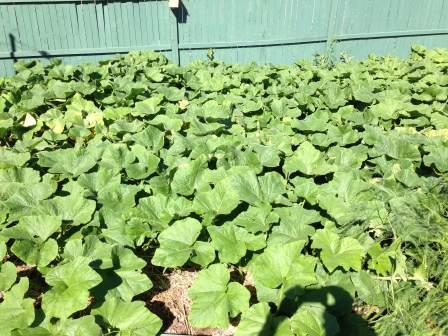Growing Winter Squash
Every year I grow enough butternut squash to harvest approximately 100 squash come September. I figure each vine will produce about 4 decent sized fruits, so 25 plants need to go into the garden in late May.
Most winter squash varieties produce long vines. I always devote the west side of our garden to my expansive friends. One year I’ll plant them against the fence on the west side and train the plants to grow in an easterly direction. The next year I plant the squash 20 feet east of the west side fence and train the vines to grow towards California.
In the space where the vines will be growing toward I plant garlic. Since garlic goes into the garden in mid October (after the squash have been harvested) and come out in early to mid July (before the squash vines reach them), I find this is an ideal rotation. That’s not to say there aren’t other equally effective rotations possible, but this one seems to work well for me.
For no particular reason I always start my winter squash in two inch peat pots in early May and put them out approximately three weeks later. I space the plants about 15” apart, peeling back the top part of the peat pot before putting them into the ground. Since squash like warm soil, I spread clear plastic over the planting beds about the same time I start the seedlings.
Once the vines begin to lengthen I educate them to grow in that year’s assigned direction. I mound a little soil over the vine 6 to 18 inches from the plant. This anchors the vine and also encourages the vine to develop additional roots at the spot of the soil mounding.
By late August the vines have taken over the west side of the garden. At this point, if I can do so without trampling the vines, I will remove flowers and undersized fruit in order to let the plant devote more of its energy toward the larger fruits.
Winter squash should be harvested before the first frost which is often toward the end of September in our locale. Cut the fruit off the vine with a pair of sharp hand clippers, leaving as much stem on the fruit as practical. Ideally the squash should be an even color (often tan) when harvested but don’t be too concerned if some appear a bit mottled.
Winter squash should ideally be cured several days in a warm, dry location. A garden shed works well, but leaving them in the garden also works well for me (but not if a frost is forecasted).
Once cured, I carefully place the squash in 5 gallon buckets and place the buckets in a warm, dark location. Handle the squash gently to avoid bruising (which can lead to spoilage). Check the squash on a weekly basis – despite your best efforts some will spoil.
I’m still eating butternut squash (the best keeper) as late as June (that’s 8 months). Most winter squash sweeten as they age in storage. Regardless, they’re always delicious.
Author:Paul Zimmermann
